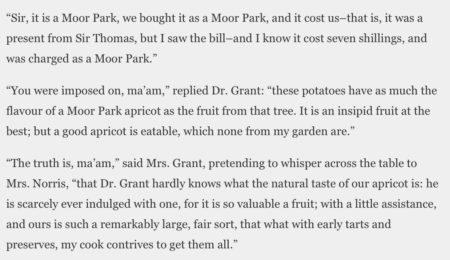- All-Africa Summit on Diversifying Food Systems with African Traditional Vegetables to Increase Health, Nutrition and Wealth. New dates! 25-28 January 2021.
- “How do you like Cocoa and Coffee? Saving crops, protecting culture, sustaining livelihoods.” Online event, 8 September. Register here.
- How the US prairies got wheat, a soil classification, tree shelter belts and weeds from the Russian steppes, thanks to Mennonite farmers and emigre Jewish scientists. Entertaining podcast on what sounds like a fascinating book. Oh and there’s a video too. Nice Vavilov anecdote.
- History of Spices 101.
- Quick summary of coconut research and development in Tanzania.
- A genebank gets off the ground in Jordan.
- How the mosquito Aedes aegypti got domesticated. Yeah, domesticated.
- Texas and Georgia move into jamón ibérico: acorns off the menu, “pecans, peanuts and sunflower” on. Hilarity ensues.
- The USDA National Plant Germplasm System gets a new database. Go crazy.
- Meanwhile, Cultivariable publishes his latest evaluation data on the USDA potato germplasm (see “Evaluation Year”). Will it find its way into the above-mentioned database?
Nibbles: Quinoa, Another quinoa, Old Apple Tree, “Anglo-Saxon” ag, SADC landraces, Record whisky, “Shipped but Not Sold”
- The results of the 2nd International Quinoa Research Symposium are up on YouTube.
- I was today years old when I learned there’s a quinoa in Taiwan.
- REALLY old English Greening apple tree dies. Sad: “When you reach your new home in the wilderness, should you ever think of me, plant these seeds.” Not all gloom, though, so do read the whole thing.
- Coming conference on the medieval agricultural revolution.
- Results of a dialogue on the registration of farmer varieties in SADC. Long way to go, alas.
- Talk about adding value to agricultural products! But were weird local barley landraces harmed in the making of this whisky?
- High value agricultural products, among other things, were used as gifts by 18th century merchants in Yemen. Not whisky, though, right? Well, actually…
Brainfood: Niche modelling, Post-2020 double, CC & productivity, Wild cacao, Popcorn data, Regulations, Duplicates, Oz ag, Kenya diversity, Stressed wheat, DUS, Connectivity, Population differentiation
- ntbox: an R package with graphical user interface for modeling and evaluating multidimensional ecological niches. Yes, another one, deal with it.
- Global targets that reveal the social–ecological interdependencies of sustainable development. The post-2020 framework should not have separate targets for social and ecological outcomes.
- Integrating agroecological production in a robust post-2020 Global Biodiversity Framework. Case in point?
- The Historical Impact of Anthropogenic Climate Change on Global Agricultural Productivity. We’ve lost a decade of productivity growth since 1961.
- Exploring the diversity and distribution of crop wild relatives of cacao (Theobroma cacao L.) in Colombia. Habitat protection needed.
- The Global Popcorn Project. Here comes the data! And more.
- Editorial: Leeway to Operate With Plant Genetic Resources. Research Topic on ABS, biosafety and IPR regulations and how they affect use of PGR.
- SNP Markers and Evaluation of Duplicate Holdings of Brassica oleracea in Two European Genebanks. Out of 10 pairs of accessions with similar names in the Russian and Nordic genebanks, 5 showed genetic differences, and 3 of these also morphological differences.
- History of crop introductions, breeding and selection in Australia: The 140 years from 1788. But at what cost?
- The welfare effects of crop biodiversity as an adaptation to climate shocks in Kenya. Crop diversity mitigates income variability risk caused by climate.
- Genetics of yield, abiotic stress tolerance and biofortification in wheat (Triticum aestivum L.). Well that seems sorted then.
- Is plant variety registration keeping pace with speed breeding techniques? No?
- Global Cropland Connectivity: A Risk Factor for Invasion and Saturation by Emerging Pathogens and Pests. Nice maps of ease of movement among different cultivation areas of vegetatively propagated crops. Could be used to model movement of genetic resources as well as of pests/diseases?
- Global patterns of population genetic differentiation in seed plants. More population differentiation for tropical, mixed‐mating, non‐woody species pollinated by small insects, and lower for temperate, outcrossing trees pollinated by wind. Could perhaps be mashed up with this fragmentation database.
Famous British apricots abroad
So Plant Heritage tweeted a few days ago about the genera that are missing from the UK’s National Plant Collections.
The Missing Genera Campaign asks people with a passion for plants to put together a National Plant Collection of their own and join the Plant Heritage community in growing, sharing and saving plants.
One of the missing plants is the apricot, so I quickly checked on Genesys to see whether anyone else around the world has British apricots stashed away. Turns out there are two apricot varieties of British origin that are conserved in genebanks that publish their data on Genesys, a fact that I posted on Twitter too. Because, why not?

And that second one turns out to be rather special. As Plant Heritage quickly informed me, the Moor Park apricot is mentioned by Jane Austen in Mansfield Park, which was published about the time of the Battle of Waterloo.

Interestingly, the Moor Park apricot in Genesys is being conserved in Italy. But there must be other specimens in the UK, surely?
Nibbles: Wild bees, Korean rice, Peanut coffee, Ag research, Sugarcane, Eat This Newsletter
- Wild bees important even if there are plenty of honeybees.
- The rice war hots up between Korea and Japan.
- Peanut coffee. Peak 2020. Hopefully.
- Op-ed on international agricultural research and indigenous knowledge systems takes us 25 years back in time to a simpler world.
- New varieties are behind sugarcane expansion in the US. You want to delve a little deeper into the history of sugarcane down South? Ok, but it ain’t pretty. Still, some people want to redeem the crop.
- Jeremy’s latest newsletter. Lots of good stuff on there. I’ll be saying a little more about it in a post.